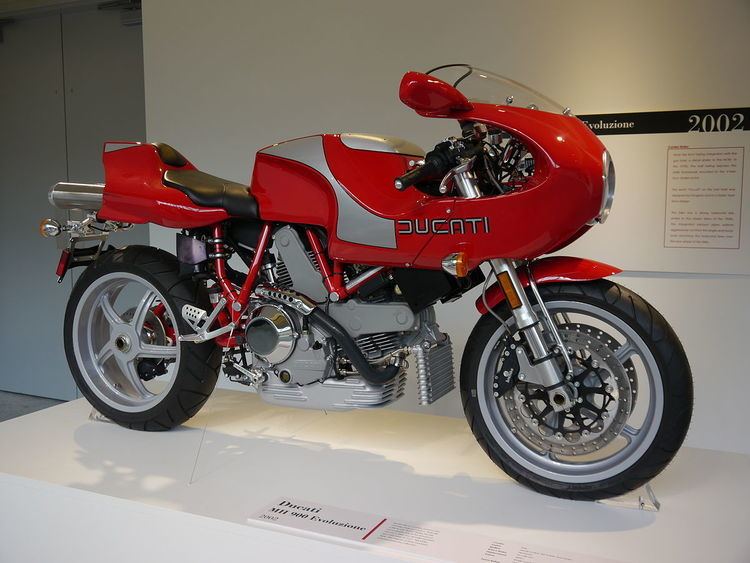Also called MH900 Evoluzione Class Sport bike, standard | ||
 | ||
Engine 904 cc (55.2 in) 90° V-twin, 2-valve OHC desmodromic, Air-cooled Bore / stroke 92 mm × 68 mm (3.6 in × 2.7 in) | ||
The Ducati MH900e (or Evoluzione) is a limited production motorcycle designed by Pierre Terblanche and was produced by Ducati in Bologna in 2001 and 2002.
Contents
Concept
The MH900e began as a concept created by the Ducati designer Pierre Terblanche in homage to Mike Hailwood's 1978 win of the Isle of Man TT. Giving way to the model designation "MH".
In September 1998 the sketch was presented to the general public at the Intermot Show in Munich and met with rave reviews. Due to the enthusiastic response from the press and public, Ducati decided to post a questionnaire on their website to test the true interest of the MH900e fans. 300 Ducatisti responded positively. With this information, Federico Minoli and Massimo Bordi (General Manager of Ducati) decided to take the risk and produce a limited run of two thousand hand-built bikes. The first one thousand bikes would be produced in 2000 and the second thousand would be produced in 2001.
The sale of the MH900e was as unique as the bike itself. Ducati made the decision to sell the new bike directly to the consumer exclusively via the Internet in a form of e-commerce known as B-2-C (Business to Consumer). This was a first for any motorcycle manufacturer. It was a risky move, but the result could not have been any better
The Ducati website opened for orders on January 1, 2000 at 00:01am GMT at a price of Euro15,000. The first 1000 units were sold out in 31 short minutes. The remaining bikes were sold over the next few weeks. Individuals made purchases from 20 different countries. The estimated breakdown of the sales was 30% from Europe, 30% from the US and 39% from Japan.
Design
The overall design of the bike was essentially a fusion of old and new. On the outside it gave off a feeling of 1970s nostalgia with the performance traits of a more modern motorcycle. While most of the concept was retained in the final production, they did swap out the exhaust integrated rear turn signals for a more conventional design and left off the rearview camera and display.
The MH900e was built around the same 904 cc (55.2 cu in) air cooled 90° v-twin engine found on the 900SS. This SOHC motor produced about 75 bhp. By today's standards that power may be a little lacking, but it provided plenty of acceleration and mid-range torque thanks to the fuel injection and lower gearing from the Monster 900. The rattle of the dry clutch alone was enough to excite most old-school enthusiasts. Terblanche wanted the motor to be a focal point of his creation and what better way to display this magnificent piece than to suspend it in Ducati's beautiful red trellis frame.
For a piece of art, the bike handled very well with its tubular steel single-sided swing arm and mono-shock in the rear, upside-down forks up front, 5 spoke wheels and Brembo's triple-disc brake system. Together with the engine, the rider was ensured an exciting ride.
To further enhance the exclusivity of the MH900e, owners were given a matching red paddock stand as well as a plaque and T-shirt marked with the production number of their new bike.
Production
The production of the MH900e was originally going to be sourced out to Bimota with production beginning the summer of 2000, but the collapse of the small company resulted in Ducati keeping the production in-house. The bike would be hand-built in a corner of the Bologna Factory at a rate of 4-5 bikes per day. Due to the unexpected changes, there was a late start in production with the first bike being produced one-year after its introduction in December 2000. Production continued into 2002 resulting in two different production years associated with the VIN's (2001 and 2002).
Suit over Hailwood name
In 2001 Pauline Hailwood, Mike Hailwood's widowed wife, sued Ducati for using her late husband's name in connection with Ducati's MH900e. Mike Hailwood never rode the MH900e and Ducati defended that the motorcycle was "inspired by the Ducati motorcycle that Mike Hailwood rode at the Isle of Man TT race in 1978". The case was settled with a retroactive license.
